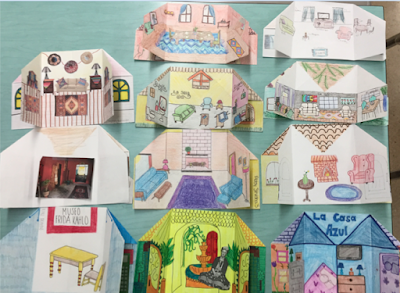Exploring daily routines with a simple game
La rutina y la gamificación en tu clase
Hola a todos,
This week I was looking for ways to maximize the traditional textbook activities about reflexive verbs and daily routines. Inspired by one of Laura's recent YouTube videos (watch it
here), I decided to go for it and here is what I experienced.
Prep time: The idea of maximizing textbook activities sounds overwhelming to many, but it is not! Allow yourself to think outside the box and the results will be so incredible you'll wonder why you did not start this sooner.
For dictation part of this particular activity there are three ways to set up.
- #1: Look into a few of those textbooks you have and just copy the routine stories that are included.
- #2: You could also type those stories so that the font is a bit bigger and easier to read.
- #3: Create original routines based on samples shared by students.
For the follow up part I simply created four different comprehension questions for each team. The key is that I wanted each group member to be accountable. This only took a few minutes per text -- many of the questions apply to multiple texts.
The activity: As Laura explains in her video, you can do this in partners or groups. Knowing my current classes, I decided to try small groups of four. I also know how clever they can be, so I made sure to have various samples going on at the same time. I posted the original texts on the board and set up the teams in pods around the classroom.
The rules: Clear rules are key so here are the few I mentioned to my students.
1. One student visits the board at a time.
2. All group members must participate. Therefore every student has to go to the board at least once.
3. No running and no yelling.
4. If they used English (non TL) then they would be penalized with 10 seconds without accessing the board.
5. Spelling out words to teammates is acceptable as long as it happens in Spanish (TL)!
Follow up: What do we do after they get the story? Once they had it completely written down, they brought it to me. I reviewed it and made sure it was accurate. Then each student was given a comprehension question to complete.
There are two ways to do this step.
1. They can write down the answer individually -- allowing students time to focus on form.
2. Students have some time to think about the answer and then come to respond verbally.
3. Students use let's recap to record their answer. This does not allow for deciding an instant winner. **Read below for a brief explanation on how awesome this app is =D
The results: I knew my students would step up to the challenge! They love competing against each other. I saw many of them actually listening to one another and the answers to the comprehension questions were filled with wonderful details they remembered!
Give this activity a try. You can download a free sample
HERE, or get four stories with four sets of comprehension questions by downloading it
HERE.
If you like this activity, please leave me a comment telling me how it worked in your classroom or perhaps something you changed to make it better!
Don't forget to follow my
Facebook Page and visit my
TpT store for more resources.


Let's recap is a really cool app that allows you to get verbal responses form students. For this particular activity, one class chose to record their responses to the comprehension questions rather than talk to me personally. The following day, we read the different routines as a class, I asked the questions and we listened to the answer from each team. Students had to decide if the answer was correct or if it missed something. In order to do the let's recap option, I extended the activity to 2 days. One for the original activity and one for going over the comprehension questions.
Time well spent!

 La hora
La hora


































